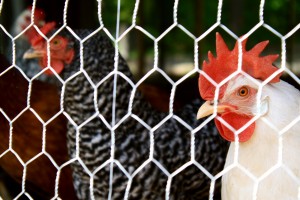 Northwood students have been busy raising a variety of animals under Gale Brickhouse, the agriculture teacher. The animals include chickens, rabbits, gerbils, geckos, turtles and chinchillas, and are kept in the barn behind the school. Brickhouse’s agriculture classes are designed to give students a hands-on experience before they enter the field of agriculture.
Northwood students have been busy raising a variety of animals under Gale Brickhouse, the agriculture teacher. The animals include chickens, rabbits, gerbils, geckos, turtles and chinchillas, and are kept in the barn behind the school. Brickhouse’s agriculture classes are designed to give students a hands-on experience before they enter the field of agriculture.
“The kids work with the small animals and some of the larger animals. By giving them an early-on experience, they’ll be able to decide whether they want to do this or not,” said Brickhouse.
Not only do the students work with the animals, but Brickhouse also teaches the students about the anatomy of the animals and the types of foods that would benefit them the most.
“We learned about the digestive systems and what to feed each of the animals so that they would be better benefitted regarding their long-term health,” said senior Lizzie Gordon, one of Brickhouse’s animal science students.
The most well-known animals kept at Northwood are the chickens that were purchased last year from Southern States, a company specializing in agriculture tools and techniques, by the small animal science class, which studies and evaluates small animals. Their names are Oreo, Hoot, Dixie, Tiffany and Harris. Before they were purchased, the class had to build a chicken coop, which was kept in the shop in Brickhouse’s classroom.
“We raised them in their chicken coop for about two or three months. This past fall we put them [in the barn] on the hill so that they would have a bigger space to roam,” said Brickhouse.
Because the chickens are laying eggs more frequently, the school plans to expand the coop. Once the eggs are laid, Brickhouse gives them to teachers at Northwood. Brickhouse also plans on taking another class to buy more baby chicks.
Many students see the chickens as pets and want them to be placed in cages every night to protect them from predators such as chicken hawks.
“One of [the chickens] got caught by a chicken hawk. It was sad; we had to read scripture, sing songs and then bury him,” said Brickhouse.
The agriculture students not only handle the barn animals, but also tend to the greenhouse, located just beside the barn. The students grow a multitude of seeds and learn how to grow them to a certain height and then plant them around the school.
Sarah Miller, one of the English teachers at Northwood, has been tending to a garden located near the greenhouse. She believes that gardening is a good way to get engaged with activism for things that everyone cares about, such as healthiness and quality of life.
“Gardening is a great way to increase your physical activity and get healthy food. Plus, food fresh from the garden tastes so much better than fancy-schmancy, organic grocery market food. Nothing can beat freshly picked produce,” said Miller.
Miller is currently working on a cool season bed that contains lettuces, radishes, collards and peas. She also has a warm season bed that contains corn, okra, squash, tomatoes and peppers. She visits the garden every day to inspect the plants for pests or any fungal infections.
“She is approaching [gardening at school] from a very ecologically sound and natural standpoint,” said principal Chris Blice.
Miller hopes that there will be a rise in student interest as she continues to work on the garden throughout the school year and into the summer.
“I’m a little concerned when the plants get bigger that the deer will think that they have a big salad bar to munch on,” said Miller.
Blice feels that the agriculture programs are a great asset, not only for the school, but for the students as well.
“It gives students the chance to find out what it is really like to work in agriculture,” said Blice. “The people involved with our agriculture program have really improved the barn and garden area. They have cleaned out the barn, fixed the water and gas lines for it, given it a new coat of paint and replaced its old doors. That area is actually being used again—it isn’t just a place for students to go hide anymore.”
— By Kristen Hutchinson
